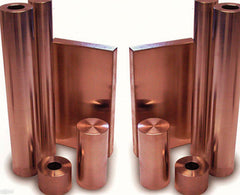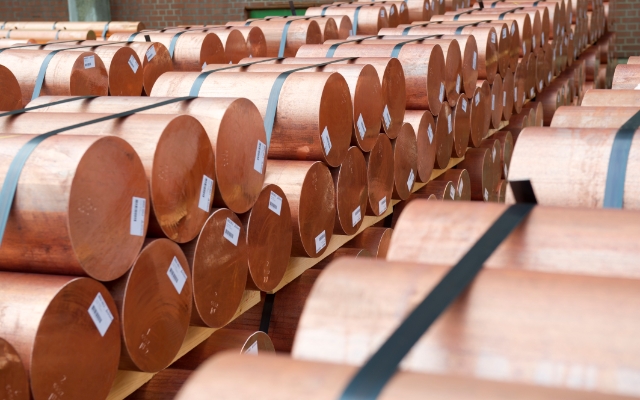From Art to Performance: The Many Applications of Special Copper Products
From Art to Performance: The Many Applications of Special Copper Products
Blog Article
Just How Copper Products Contribute to Sustainable Practices in Various Fields
Copper items are progressively acknowledged for their substantial payments to lasting methods throughout several markets, driven by their intrinsic properties such as longevity, effectiveness, and recyclability. In sustainable power systems, for example, copper improves the functionality of solar and wind modern technologies, while its application in building and construction lessens waste with long life. Additionally, the product's antimicrobial characteristics offer appealing benefits in health care settings. As sectors seek to take on even more sustainable practices, the function of copper might verify critical in achieving environmental goals. What ramifications might this have for future developments in sustainability?
Copper in Renewable Power
Copper plays a vital role in the innovation of eco-friendly power modern technologies, working as a crucial conductor in different applications. Its remarkable electrical conductivity and resistance to corrosion make it a perfect product for electric wiring, which is vital in photovoltaic panels, wind turbines, and power storage space systems. In solar photovoltaic systems, copper is used in the interconnections and wiring, enabling reliable energy conversion from sunlight to electricity.
In wind energy, copper is essential to the generators and transformers that convert kinetic power into electric energy, making certain ideal efficiency and integrity. The demand for electrical lorries (EVs) is raising, with copper being a key element in batteries, motors, and billing facilities. The change to EVs significantly enhances the demand for copper, as these cars commonly make use of 4 times extra copper than traditional internal burning engine automobiles.
As the globe seeks to alleviate environment change and change to sustainable energy resources, copper's role becomes significantly crucial. The product not only enhances the effectiveness and resilience of renewable resource systems yet additionally sustains the wider objective of lowering greenhouse gas exhausts and advertising a sustainable future.
Eco-Friendly Building And Construction Materials
In current years, there has actually been a remarkable shift in the direction of the adoption of environment-friendly building materials in response to expanding environmental worries. This change is encouraged by the need for sustainable options that minimize environmental footprints while maintaining architectural stability and visual charm.
Copper, understood for its durability and recyclability, has emerged as a principal in this industry. It can be used in roof, pipes, and electric systems, adding to energy efficiency and reducing waste. Copper's longevity suggests less substitutes over time, more improving its sustainability profile.
Additionally, materials such as bamboo, reclaimed wood, and reused steel are getting popularity. These alternatives not just use lowered ecological impact yet also promote resource preservation. As building codes significantly stress sustainability, home builders and designers are incorporating these products into their tasks, fostering innovation in design.
The raising adoption of eco-friendly building materials shows a wider dedication to sustainability in the developed setting. By prioritizing these products, the building sector can substantially minimize its carbon footprint, align with regulatory standards, and sustain a much healthier environment for future generations. This fad marks a critical step towards an extra lasting future in building.
Copper's Function in Healthcare
Current researches have actually highlighted the substantial duty of copper in health care settings, particularly as a result of its antimicrobial homes. Copper surfaces have actually been revealed to reduce the presence of virus, including infections and germs, by as much as 99.9% within a brief period. This impressive efficiency makes copper a vital product for high-touch surfaces in hospitals, such as doorknobs, bed rails, and IV posts, thus adding to boosted infection control actions.
In addition to its straight antimicrobial effects, copper additionally plays a role in the more comprehensive context of medical facility sustainability (Copper Products). By integrating copper right into clinical devices and home furnishings, medical care facilities can decrease the occurrence of healthcare-associated infections (HAIs), which not just enhances patient results however additionally lowers the expenses connected with prolonged hospital keeps and extra therapies
Additionally, copper's resilience and recyclability straighten with lasting methods, enabling responsible source management. As health care systems increasingly prioritize both client security and environmental stewardship, the integration of copper items is ending up being more common. This double benefit highlights copper's vital contribution you could try these out to a healthier, much safer, and more sustainable health care atmosphere.
Sustainability in Transport

In addition, copper's toughness and deterioration resistance contribute to the longevity of transportation facilities (Copper Products). In rail systems, for example, copper parts improve the reliability and performance of signaling and power systems, crucial for reducing delays and energy intake. Furthermore, copper's role in eco-friendly energy systems, such as solar and wind, supports sustainable transportation solutions websites by providing clean power for electric transit alternatives
Investments in copper modern technology not only foster sustainability yet additionally boost financial development and work development in eco-friendly industries. As sectors make every effort to meet rigid ecological regulations, the application of copper products in transportation becomes a critical method in attaining sustainability objectives and promoting a cleaner, much more effective future.
Copper and Circular Economic Climate
As the world increasingly embraces sustainability, the role of copper in the circular economic climate becomes ever a lot more significant. Copper's intrinsic buildings-- such as its sturdiness, recyclability, and conductivity-- placement it as an essential product in a resource-efficient economic situation. The round economy aims to decrease waste and make the most of source use with recycling and reusing products, and copper excels in this regard.
The metal can be recycled forever without loss of high quality, making it a suitable candidate for lasting techniques throughout different markets, including building and construction, electronics, and renewable resource. By reprocessing and recouping copper from end-of-life products, markets can significantly lower the need for virgin materials, thus decreasing ecological influences connected with mining and processing.
Moreover, the combination of copper right into round economy structures not just saves sources however likewise cultivates technology. Businesses that focus on copper recycling contribute to a more lasting supply chain, boosting their competitiveness while lining up with regulatory needs and customer preferences for environmentally accountable products.
Conclusion
Finally, copper items significantly contribute to sustainable methods across numerous fields. Their important duty in boosting renewable energy technologies, advertising environmentally friendly building and construction materials, supporting infection control in healthcare, promoting lasting transportation, and embodying the concepts of a circular economic situation highlights the convenience and relevance of copper. By incorporating copper into numerous applications, sectors can accomplish higher performance, lower ecological effect, and line up with international sustainability goals, ultimately fostering a more lasting future.

Copper's outstanding conductivity makes it a preferred product in electric vehicle (EV) systems, boosting energy performance and performance. Additionally, copper's duty in renewable energy systems, such as solar and wind, sustains lasting transportation solutions by offering tidy power for electric transportation alternatives.
Their crucial role in boosting sustainable power innovations, promoting environment-friendly building products, sustaining infection control in healthcare, promoting lasting transport, and personifying the principles of a circular economic situation underscores the adaptability and page significance of copper.
Report this page